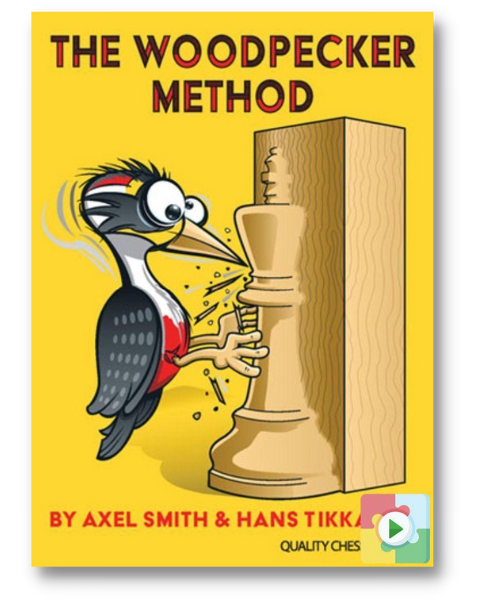
Woodpecker method
Chess, a game as ancient as civilization itself, has been dissected, studied, and refined for centuries. The rise of different training techniques over time has offered players many ways to improve their skills. One such technique is the Woodpecker Method. Based on the book “The Woodpecker Method” by Axel Smith and Hans Tikkanen, this approach to chess training provides a unique take on improving calculation and pattern recognition skills. Let’s take a look at what exactly this method is all about.

What does the Woodpecker Method mean?
The term “Woodpecker Method” is based on the rhythmic pecking of woodpeckers. Just as a woodpecker repetitively strikes the same spot, this method entails repetitive solving of the same set of chess problems until patterns are deeply ingrained in the player’s memory.
However, the name also has a more personal meaning for the authors, and stated in their introduction:

The Core Principle of the Woodpecker Method
The primary essence of the Woodpecker Method lies in its cyclical nature. Instead of solving countless new puzzles every day, players work through a set selection of problems multiple times. By doing so, they internalize the patterns, tactics, and strategies within these puzzles, gradually reducing the time needed to solve them. The method is based on three “cycles”:
- Initial Cycle: Players start by solving a set of chess problems, marking the time taken for each one. This initial round is more about understanding the puzzle and less about speed.
- Subsequent Cycles: Once the set is complete, players begin again, attempting to solve the puzzles more quickly than in the initial cycle. The goal is to recognize patterns faster and increase calculation speed.
- Final Cycle: By the time players reach their last cycle, they should be able to solve the puzzles significantly faster than their first attempt, demonstrating a deep internalization of the patterns.
The book gives the reader three difficulty levels; easy, intermediate, and advanced exercises. This means that no matter your level, there is something for you, and moreover, you can aim to “climb” up and progress to the advanced level.
Woodpecker Method Exercise Examples
Let’s take a look at example exercises from each level:
Easy Exercises
Intermediate Exercises
Advanced Exercises
Benefits of the Woodpecker Method & Expected Results
Pattern Recognition: Regular exposure to the same set of problems reinforces the patterns and tactical motifs in a player’s mind. Over time, these patterns become second nature, allowing for quicker recognition during actual games.
Enhanced Calculation Skills: As players work through the puzzles repetitively, they begin to calculate variations faster and with more accuracy.
Focus on Quality: Instead of jumping from one random puzzle to the next, players focus on a select set, ensuring quality over quantity in their training.
The authors exemplify the achievable results from using the Woodpecker method; Hans Tikkanen trained with the method in the Spring of 2010 and achieved three GM norms as well as +2500 rating that Summer! He elaborates on his successful training with the following:
Such quick results from any type of chess training are rare in my experience, but for me the Woodpecker Method seemed to be just what the doctor ordered! The increased tactical acuity and consistency that came from working so hard with the method significantly decreased my blunders and made me more confident at the board.
Would I have made the same improvement with some other type of training? It’s not impossible – but my playing strength had not taken any significant leap in years, so I had been at a loss as to what to do differently to succeed. Although the Woodpecker Method probably wasn’t the only way for me to raise my play, it certainly proved to be a way.
Just with any training method, the secret ingredient will always be consistency, and the Woodpecker Method’s foundation lies on just that.
Implementing the Method
For those intrigued by the Woodpecker Method, starting is straightforward. Smith and Tikkanen’s book provides over 1000 puzzles, all carefully selected for this approach. However, players can also compile their own set of puzzles The key is consistency in revisiting the same set of problems and continually striving to improve speed and accuracy.
Ultimately, the Woodpecker Method by Axel Smith and Hans Tikkanen offers a fresh perspective on chess training. By emphasizing repetition, pattern recognition, and quality of practice, it presents a systematic approach to enhancing one’s skills. While not every method works equally well for every player, the Woodpecker Method is certainly worth a try for those looking to take their game to the next level.
Take a look at the wide range of tactics books available on Forward Chess. Happy solving!
Exercise Solutions
Easy 1:
Easy 2:
Easy 3:
Intermediate 1:
Intermediate 2:
Intermediate 3:
Advanced 1:
Advanced 2:
Advanced 3: